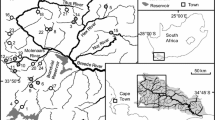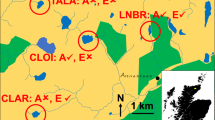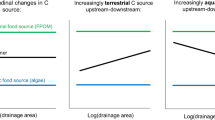Abstract
Movements of prey organisms across ecosystem boundaries often subsidize consumer populations in adjacent habitats. Human disturbances such as habitat degradation or non-native species invasions may alter the characteristics or fate of these prey subsidies, but few studies have measured the direct effects of this disruption on the growth and local abundance of predators in recipient habitats. Here we present evidence, obtained from a combined experimental and comparative study in northern Japan, that an invading stream fish usurped the flux of allochthonous prey to a native fish, consequently altering the diet and reducing the growth and abundance of the native species. A large-scale field experiment showed that excluding terrestrial invertebrates that fell into the stream with a mesh greenhouse reduced terrestrial prey in diets of native Dolly Varden charr (Salvelinus malma) by 46–70%, and reduced their growth by 25% over six weeks. However, when nonnative rainbow trout (Oncorhynchus mykiss) were introduced, they monopolized these prey and caused an even greater reduction of terrestrial prey in charr diets of 82–93%, and reduced charr growth by 31% over the same period. Adding both greenhouse and rainbow trout treatments together produced similar results to adding either alone. Results from a comparative field study of six other stream sites in the region corroborated the experimental findings, showing that at invaded sites rainbow trout usurped the terrestrial prey subsidy, causing a more than 75% decrease in the biomass of terrestrial invertebrates in Dolly Varden diets and forcing them to shift their foraging to insects on the stream bottom. Moreover, at sites with even low densities of rainbow trout, biomass of Dolly Varden was more than 75% lower than at sites without rainbow trout. Disruption of resource fluxes between habitats may be a common, but unidentified, consequence of invasions, and an additional mechanism contributing to the loss of native species



Similar content being viewed by others
References
Baxter CV, Fausch KD, Murakami M, Chapman PL (2004) Non-native stream fish invasion restructures stream and forest food webs by interrupting reciprocal prey subsidies. Ecology 85:2656–2663
Baxter CV, Fausch KD, Saunders WC (2005) Tangled webs: reciprocal flows of invertebrate prey link streams and riparian zones. Freshw Biol 50:201–220
Cooper SD, Diehl S, Kratz K, Sarnelle O (1998) Implications of scale for patterns and processes in stream ecology. Aust J Ecol 23:27–40
Diamond J (1986) Overview: laboratory experiments, field experiments, and natural experiments. In: Diamond J, Case T (eds) Community ecology. Harper & Row, New York, pp 3–22
Duggins DO, Simenstad CA, Estes JA (1989) Magnification of secondary production by kelp detritus in coastal marine ecosystems. Science 24:170–173
Englund G, Cooper SD (2003) Scale effects and extrapolation in ecological experiments. Adv Ecol Res 33:161–213
Fausch KD (1998) Interspecific competition and juvenile Atlantic salmon (Salmo salar): on testing effects and evaluating the evidence across scales. Can J Fish Aquat Sci 55:218–231
Fausch KD, Nakano S, Ishigaki K (1994) Distribution of two congeneric charrs in streams of Hokkaido Island, Japan: considering multiple factors across scales. Oecologia 100:1–12
Fausch KD, Nakano S, Kitano S (1997) Experimentally induced foraging mode shift by sympatric charrs in a Japanese mountain stream. Behav Ecol 8:414–420
Fausch KD, Taniguchi Y, Nakano S, Grossman GD, Townsend CR (2001) Flood disturbance regimes influence rainbow trout invasion success among five holarctic regions. Ecol Appl 11:1438–1455
Giles N (1980) A stomach sampler for use on live fish. J Fish Biol 16:139–153
Hasegawa K, Yamamoto T, Murakami M, Maekawa K (2004) Comparison of competitive ability between native and introduced salmonids: evidence from pairwise contests. Ichthyol Res 51:191–194
Ishigaki K (1984) Exploring the mystery of charrs. Iwanamishoten, Tokyo
Kawaguchi Y, Nakano S (2001) Contribution of terrestrial invertebrates to the annual resource budget for salmonids in forest and grassland reaches of a headwater stream. Freshw Biol 46:303–316
Kawaguchi Y, Nakano S, Taniguchi Y (2003) Terrestrial invertebrate inputs determine the local abundance of stream fishes in a forested stream. Ecology 84:701–708
Kennedy TA, Hobbie SA (2004) Saltcedar (Tamarix remosissima) invasion alters organic matter dynamics in a desert stream. Freshw Biol 49:65–76
Kitano S (2004) Ecological impacts of rainbow, brown and brook trout in Japanese inland waters. Glob Environ Res 8:41–50
Kitano F, Nakano S, Maekawa K, Ono Y (1995) Effect of stream temperatures on longitudinal distribution of fluvial Dolly Varden and potential loss due to global warming. Wildl Conserv 1:1–11
Matthews KR, Knapp RA, Pope KL (2002) Garter snake distributions in high-elevation aquatic ecosystems: is there a link with declining amphibian populations and non-native trout introductions? J Herpetol 36:16–22
Morita K, Tsuboi J, Matsuda H (2004) The impact of exotic trout on native charr in a Japanese stream. J Appl Ecol 41:962–972
Murakami M, Nakano S (2002) Indirect effect of aquatic insect emergence on a terrestrial insect population through bird predation. Ecol Lett 5:333–337
Nakano S, Murakami M (2001) Reciprocal subsidies: dynamic interdependence between terrestrial and aquatic food webs. Proc Natl Acad Sci USA 98:166–170
Nakano S, Kitano F, Maekawa K (1996) Potential fragmentation and loss of thermal habitats for charrs in the Japanese archipelago due to climatic warming. Freshw Biol 36:711–722
Nakano S, Fausch KD, Kitano S (1999) Flexible niche partitioning via a foraging mode shift: a proposed mechanism for coexistence in stream-dwelling charrs. J Anim Ecol 68:1079–1092
Nakano S, Kawaguchi Y, Taniguchi Y, Miyasaka H, Shibata Y, Urabe H, Kuhara N (1999) Selective foraging on terrestrial invertebrates by rainbow trout in a forested headwater stream in northern Japan. Ecol Res 14:351–360
Nakano S, Miyasaka H, Kuhara N (1999) Terrestrial-aquatic linkages: riparian arthropod inputs alter trophic cascades in a stream food web. Ecology 80:2435–2441
O’Connor PJ, Covich AP, Scatena FN, Loope LL (2000) Non-indigenous bamboo along headwater streams of the Loquillo Mountains, Puerto Rico: leaf fall, aquatic leaf decay and patterns of invasion. J Trop Ecol 16:499–516
Orth DJ (1983) Aquatic habitat measurements. In: Nielson LA, Johnson DL (eds) Fisheries techniques. American Fisheries Society, Bethesda, pp 61–84
Otis D, Burnham KP, White GC, Anderson DR (1978) Statistical inference from capture data on closed animal populations. Wildl Monogr 62:1–135
Parker IM, Simberloff D, Lonsdale WM, Goodell K, Wonham M, Kareiva PM, Williamson MH, Von Holle B, Moyle PB, Byers JE, Goldwasser L (1999) Impact: toward a framework for understanding the ecological effects of invaders. Biol Invasions 1:3–19
Peacor SD, Werner EE (1997) Trait-mediated indirect interactions in a simple aquatic food web. Ecology 78:1146–1156
Peckarsky BL, Cooper SD, McIntosh AR (1997) Extrapolating from individual behavior to populations and communities in streams. J North Am Benthol Soc 16:375–390
Peterson DP, Fausch KD (2003) Testing population-level mechanisms of invasion by a mobile invertebrate: a simple conceptual framework for salmonids in streams. Biol Invasions 5:239–259
Polis GA, Anderson WB, Holt RD (1997) Toward an integration of landscape and food web ecology: the dynamics of spatially subsidized food webs. Annu Rev Ecol Syst 28:289–316
Polis GA, Power ME, Huxel GR (2004) Food webs at the landscape level. University of Chicago Press, Chicago
Polis GA, Wise DH, Hurd SD, Sanchez-Pinero F, Wagner JD, Jackson CT, Barnes JD (1998) The interplay between natural history and field experimentation. In: Resetarits WJ Jr, Bernardo J (eds) Experimental ecology. Oxford University Press, New York, pp 254–280
Power ME, Deitrich WE, Sullivan KO (1998) Experimentation, observation, and inference in river and watershed investigations. In: Resetarits WJ Jr, Bernardo J (eds) Experimental ecology. Oxford University Press, New York, pp 113–132
Power ME, Rainey WE (2000) Food webs and resource sheds: towards spatially delimiting trophic interactions. In: Hutchings MJ, John EA, Stewart AJA (eds) Ecological consequences of habitat heterogeneity. Blackwell, Oxford, pp 291–314
Resetarits WJ Jr, Bernardo J (eds) (1998) Experimental ecology: issues and perspectives. Oxford University Press, New York
Riley SC, Fausch KD (1995) Trout population response to habitat enhancement in six northern Colorado streams. Can J Fish Aquat Sci 52:34–53
Sabo JL, Power ME (2002) Numerical response of lizards to aquatic insects and short-term consequences for terrestrial prey. Ecology 83:3023–3036
Sabo JL, Power ME (2002) River-watershed exchange: effects of riverine subsidies on riparian lizards and their terrestrial prey. Ecology 83:1860–1869
SAS Institute (1999) SAS version 8 e. SAS Institute, Cary, N.C.
Simberloff D (1997) The biology of invasions. In: Simberloff D, Schmitz DC, Brown TC (eds) Strangers in paradise: impact and management of nonindigenous species in Florida. Island Press, Covelo, pp 3–20
Spencer CN, McClelland BR, Stanford JA (1991) Shrimp stocking, salmon collapse, and eagle displacemnent: cascading interactions in the food web of a large aquatic ecosystem. BioScience 41:14–21
Takami T, Aoyama T (1999) Distributions of rainbow trout and brown trout in Hokkaido, northern Japan. Wildl Conserv 4:41–48
Takami T, Kitano F, Nakano S (1997) High water temperature influences on foraging responses and thermal deaths of Dolly Varden Salvelinus malma and white-spotted charr S. leucomaenis in a laboratory. Fish Sci 63:6–8
Taniguchi Y, Fausch KD, Nakano S (2002) Size-structured interactions between native and introduced species: can intraguild predation facilitate invasion by stream salmonids? Biol Invasions 4:223–233
Taniguchi Y, Miyake Y, Saito T, Urabe H, Nakano S (2000) Redd superimposition by introduced rainbow trout, Oncorhynchus mykiss, on native charrs in a Japanese stream. Ichthyol Res 47:149–156
Trussell GC, Ewanchuk PJ, Bertness MD (2003) Trait-mediated effects in rocky intertidal food chains: predator risk cues alter prey feeding rates. Ecology 84:629–640
Werner EE (1992) Individual behavior and higher-order species interactions. Am Nat 140[Supplement]:S5–S32
White GC, Anderson DR, Burnham KP, Otis D (1982) Capture-recapture and removal methods for sampling closed populations. Los Alamos National Laboratory LA-8787-NERP, Los Alamos
Acknowledgments
This research could not have been completed without the help of J. Jordan, K. Tatara, Y. Miyake, A. Uesugi, S. Laeser, H. Asano, K. Ono, S. Bailey, K. Ross, J. Monroe, Y. Inagaki, T. Ishii, Y. Taniguchi, M. Inoue, and L. Weaver-Baxter. We also received assistance from D. Fukui, K. Hasegawa, T. Iwata, K. Kasugai, N. Kazahari, D. Kishi, B. Kondratieff, M. Matsuda, M. Miura, H. Miyata, K. Motomori, E. Nabeshima, T. Nakahara, F. Okabe, K. Onishi, T. Sugata, K. Takahashi, G. Takimoto, T. Tosuji, H. Urabe, H. Yorozuya, and the staff at the Tomakomai Research Station. We thank J. Dunham, J. Olden, J. Monroe, and four anonymous reviewers for comments that improved the manuscript. Protocols for fish sampling were approved by the Animal Care and Use Committee of Colorado State University (Protocol 01-164A). This study was supported by a National Science Foundation grant (DEB 0108222) to K.D. Fausch, fellowships from the Japan Society for the Promotion of Science to C.V. Baxter and K.D. Fausch, and Japanese Ministry of Education, Science, Sport, and Culture grants to M. Murakami.
Author information
Authors and Affiliations
Corresponding author
Additional information
Communicated by Pete Peterson.
Electronic supplementary material
Below is the link to the electronic supplementary material.
442_2007_743_MOESM1_ESM.doc
S1. Top Dolly Varden charr (Salvelinus malma), or oshorokoma, native to streams of Hokkaido, Japan, are threatened by the invasion of non-native rainbow trout. Bottom A spring stream in Hokkaido that has not been invaded by rainbow trout and which currently has high densities of native Dolly Varden. Photo credits: C.V. Baxter (top) and K.D. Fausch (bottom) (DOC 161 kb)
442_2007_743_MOESM2_ESM.doc
S2. Stream habitat and riparian vegetation characteristics at the six sites surveyed in the comparative study during summer 2003. Values are means + 1 SE, and sample sizes are in parentheses. Sites had either native Dolly Varden charr in allopatry (DV), Dolly Varden and low relative abundance of non-native rainbow trout (DV + low RBT), or Dolly Varden and rainbow trout in about equal relative abundance (DV = RBT) (DOC 59 kb)
Rights and permissions
About this article
Cite this article
Baxter, C.V., Fausch, K.D., Murakami, M. et al. Invading rainbow trout usurp a terrestrial prey subsidy from native charr and reduce their growth and abundance. Oecologia 153, 461–470 (2007). https://doi.org/10.1007/s00442-007-0743-x
Received:
Accepted:
Published:
Issue Date:
DOI: https://doi.org/10.1007/s00442-007-0743-x




